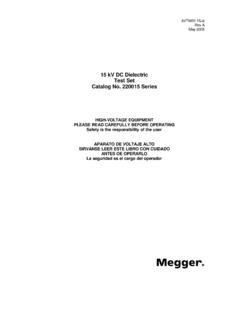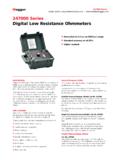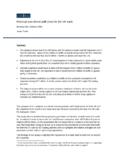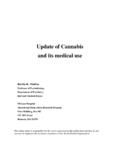Transcription of easuring Ground Resistance — The Fall of Potential Method
1 Spring 20021 The basic procedure for testing Ground electrodesis described by The Institute of Electrical andElectronics Engineers in IEEE Standard #81, IEEER ecommended Guide for Measuring Ground Resistance andPotential Gradients in the Earth. A grounding electrodeis defined as a conductor embedded in the earth, usedfor maintaining Ground Potential on conductors con-nected to it, and for dissipating into the earth currentconducted to it. It should be obvious that the effi-ciency of the electrode is inversely proportional to theresistivity of the surrounding earth. Ideally, it wouldbe nice to have a Resistance of zero, but that is notpractically realizable.
2 Values of a fraction of an ohmcan be achieved, however, with appropriate diligenceapplied to the design. A reliable means must, there-fore, be available to test the efficiency of such an in-stallation. Note that while grounding electrodes canvary from a single rod to a grid or array that is severalMeasuring Ground Resistance The fall of Potential Methodby Jeff JowettAVO Internationalhundred feet across,the fundamentals oftesting are the are some com-paratively minor con-siderations in tech-nique and procedurethat apply to specific types of electrodes, but the simi-larities far outweigh the differences in testing acrossthe spectrum of electrode most fundamental and general of proceduresis called fall of Potential .
3 There are others, gener-ally devised with an eye toward simplification, butthey suffer from notable limitations that are includedin their IEEE 81 descriptions. The most thorough andreliable Method is fall of Potential . Its shortcomingsare largely psychological, so it is worthwhile for theoperator to understand what the test is doing and Official Publication of the InterNational Electrical Testing AssociationWinter 1999-2000 Tech TipsSpring 20022 NETA WORLDWhen an electrode is buried and the electrical system tied to it, anelectrical connection has been made with the entire Planet Earth. Thissounds like a tall order!
4 But, in fact, one need only be concerned with theimmediate environment. It is like a Physics 101 question: if you fire agun, does the Earth recoil? Yes, it does, but to such an infinitesimal de-gree that it is of no consequence, except possibly to musings on the theo-retical level. Grounding acts much the same way. Fault current going toground encounters Resistance from the immediate environment, but be-cause it is free to spread out in all directions, attenuation is rapid. If thiswere not so, the whole concept of grounding would be ineffective! In aconventional circuit, the gauge of the wire holds this parameter in a Ground circuit, the current path is rapidly expanding with dis-tance from the electrode.
5 The net effect is that any significant resistanceis concentrated in the area immediately around the buried electrode. Be-yond a critical distance, the rest of the planet offers so little additionalresistance as to be, like the recoil from a rifle, of no practical phenomenon can be thought of like the dirt around the roots of aballed tree. A certain critical volume is required to maintain the tree. Simi-larly, a critical volume of soil surrounding the electrode determines itscapabilities. In fairly standard environments, with moist, water-reten-tive soil, this volume is small, perhaps on the order of twenty feet or in difficult areas, with dry, sandy, or rocky soil, it can extend hun-dreds of feet.
6 Further, a temporal effect superimposes upon the basicrelationship of electrode design to surrounding soil. Rainfall contractsthe field of influence and lowers Resistance . Dry conditions and freezingexpand and increase it. A test Method , therefore, must be flexible, adapt-able, and 1 Lab technicians generally workin a controlled environment inwhich the technician is master ofthe situation. Circuitry and com-ponents are laid out according to aschematic which rigorously guidesthe investigation. Measurementstend to be predictable or, if not,point the way toward their correc-tion. A Ground test, on the otherhand, is being performed on planetearth.
7 Any alteration of results islikely to involve some form of ex-cavation. This can be intimidatingto someone trained on a workers are used to think-ing on their feet in atypical situa-tions. But the rigors of a fall of po-tential test tend to seem impracti-cal, and they would like to havesomething more , a Ground test is notbeing performed on a circuit in theconventional sense, where currentis being neatly directed from pointto point by human design. Rather,it is governed by nature, in theform of local soil and geologicalconditions, and it is the humanwho must adapt. That does not sitwell with many operatives. But itis precisely what the fall of poten-tial test was designed to going to Ground via a bur-ied electrode is not constrained tofollow a straight-line path in theway we commonly think of elec-trical current.
8 This is a critical dif-ference in the nature of a groundtest. Fault current radiates in all di-rections from the electrode. It is theability of the surrounding soil toaccommodate this pattern of dis-persal that determines how goodor poor the Ground connection isand to which the test procedureand instrumentation must 20023A fall of Potential test is the most general of methods for meeting theabove criteria. It may also be referred to colloquially as a three-point test, although this term is also applied to a separate test that is likewisedefined in IEEE 81. With reference to fall of Potential , three points ofcontact are made with the soil.
9 One is the connection to the electrodeunder test. The other two are probes that the operator places in the soil,one for current and the other for Potential . The test set acts as a currentsource, and the current probe establishes a circuit through the soil viathe electrode under test. The Potential probe then senses the voltage gra-dient established by the test current against the local soil Resistance . Withcurrent and voltage drop accurately measured, the test set simply usesOhm s law to calculate and display the , right? Yes, from the standpoint of theory of operation, it is. Toavoid polarization effects, the test sets commonly employ an alternatingsquare wave current.
10 IEEE suggests this be at or near power frequency. Aslight offset from multiples of the utility frequency enables the test set tobase its reading on its own signal without interference from utility har-monics. Lightning strikes occur at high frequencies, and both those andground faults can involve enormous currents. Some test sets do operatewith high frequencies and currents, but these are dedicated toward spe-cialized investigations. For everyday practical use, microprocessor sen-sitivity permits test sets to be portable and simple to operate while af-fording a reasonable approximation of the test Ground s capabilities whencalled 2 The complication that manyfind frustrating is the are used to hooking upand taking a reading.

















